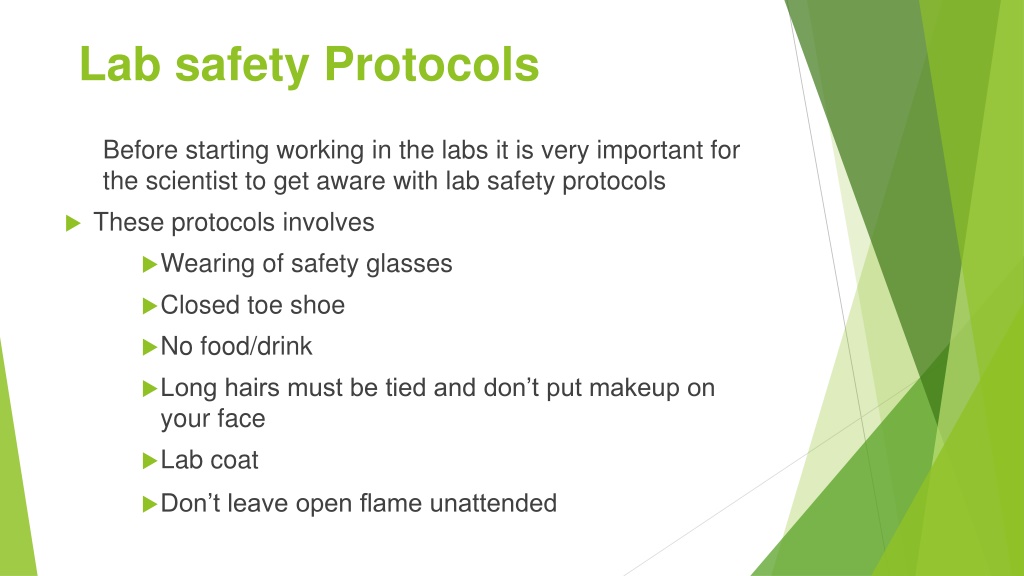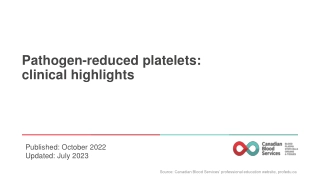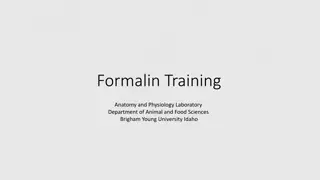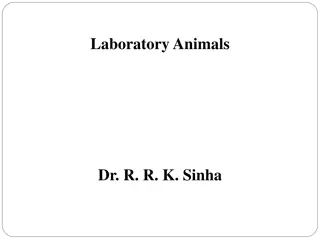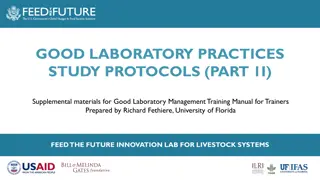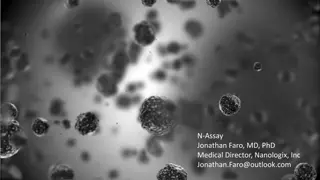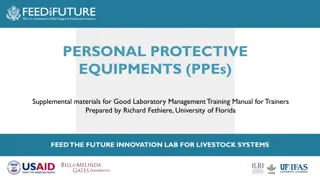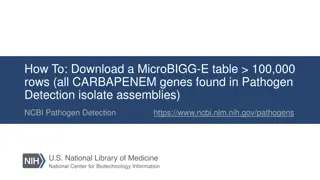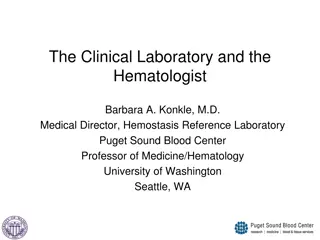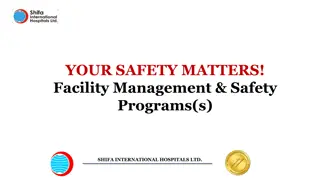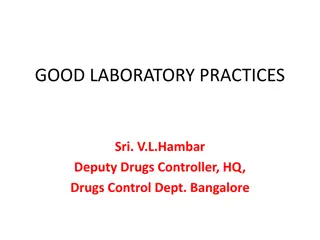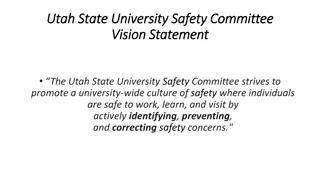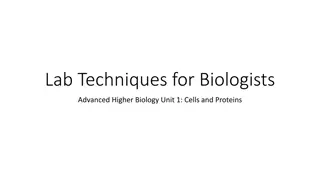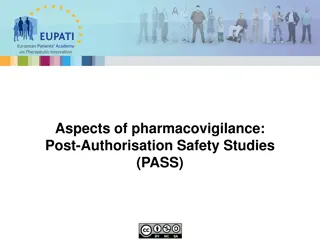Laboratory Safety Protocols and Pathogen Classification
Scientist must adhere to lab safety protocols including wearing safety gear, proper waste disposal, and handling chemicals carefully. The classification of pathogens varies by country based on WHO guidelines into four risk groups. Understanding these protocols and classifications is crucial for a safe laboratory environment.
Download Presentation

Please find below an Image/Link to download the presentation.
The content on the website is provided AS IS for your information and personal use only. It may not be sold, licensed, or shared on other websites without obtaining consent from the author. Download presentation by click this link. If you encounter any issues during the download, it is possible that the publisher has removed the file from their server.
E N D
Presentation Transcript
Lab safety Protocols Before starting working in the labs it is very important for the scientist to get aware with lab safety protocols These protocols involves Wearing of safety glasses Closed toe shoe No food/drink Long hairs must be tied and don t put makeup on your face Lab coat Don t leave open flame unattended
Lab Safety Protocols Flammable liquids should not be open or in refrigerator If you have irritation on your skin because of some chemical, rinse that area with water thoroughly Proper waste disposal (Sharp box and Yellow trash box with sign of hazards should be available in the lab) Liquid waste should be placed in container labelled it properly and then put it in the trash box Equipment should be cleaned and placed back
Lab Safety Protocols If there is any chemical spillage even thermometer is broken you should inform your biosafety officers As scientist you should handled hot glassware, chemicals and equipment very carefully Never takeout the excess amount of chemicals, it is possible that fumes of chemical may contaminated the lab. May cause skin irritation, eye irritation and many other problems Cell phone, headphones, Chairs are not permitted in the lab Lab doors must be kept closed
Lab Safety Protocols Lab must be fully equipped with lab safety equipment it include fire extinguishers Fire blanket and safety shower should be available In case of any irritation in eyes, wash thoroughly and use first aid kits Fume hoods Sodium hydrogen carbonate, bleach powder and 70% alcohol types of disinfectant should be available in the lab
Classification of Pathogens For the classification of pathogens every country has different rules Australia, UK, Russia classify the pathogens according to their own environment In Pakistan pathogens are classified by following WHO rules According to WHO pathogens are classified into four groups 1. WHO Risk group 1 2. WHO Risk group 2 3. WHO Risk group 3 4. WHO Risk group 4
WHO Classification of Pathogens WHO Risk Group 1: Includes the microbes unlike to cause disease WHO Risk Group 2: Microbes like to cause diseases but unlikely to be serious WHO Risk Group 3: Pathogens cause serious diseases WHO Risk Group 4: Pathogens cause serious diseases, likely chance of transmission and effective treatment of preventive measures are available examples Dengue, Ebola and Corona virus
Containment These are safety measures to manage micro organism which we are using for research To avoid the exposure of work to biohazards or infectious agents Containment can be defined as Military strategy to stop the expansion of enemies It was first introduced by the USA and for Containment the policy used is known as Cold War Policy The purpose of policy was prevention of spread of communism abroad
History of Containment Containment strategy was started in USA in 1850 to stop the expansion of slavery and ultimately forcing it collapse and developed Anti-slavery forces. In 1940 during World War II USA and Soviet Union developed rollback policy in order to destroy Japan and Germany They use three types of strategies for containment 1. Isolationism: Minimize the involvement 2. Friendly relationship: Important for trade 3. Roll back policy
Handling of Biological Spills During the lab work if there is any sort of spills and some worker is injured first give first aid to worker and then clean spills You have to alert all other individuals, workers in the vicinity of that lab Clean up the spill and decontaminate with disinfectant Dispose off the clean up trash after sterilization in yellow box Report the incident to safety officer so that he/ she can investigate the incident and can report to high authorities If you skin get infect use 70% alcohol for disinfection If there is some sort of irritation in the eyes, wash them thoroughly
Biological Spill Kits 1. House hold bleach 2. 70% Alcohol 3. Spray bottle 4. Sterilization bags 5. Absorbent paper towel 6. Yellow trash bags 7. Disposable gloves 8. Metallic tong 9. Surgical Mask 10.Safety goggles, shoe covers and face mask 11.Spill control and clean procedures should be available in the lab
Management of Spills There are two types of spills Small Spills 1. Wear gloves, Mask, shoe cover, lab coat Clean up the area with 70% Alcohol If Absorbent paper towel should be sterilized before disposal 2. Large Scale Spills Wear gloves, mask, shoe cover inform in vicinity about the incident. Open the fume hood to avoid the environmental contamination In this condition don t clean spills immediately allow the fumes to settle down and then Add bleach on the spills and leave for 20mins Clean the area and disinfect properly
Sterilization and Disinfectants Sterilization is the process through which we can kill all sort of micro organisms including bacterial spores Disinfectant we can kill those microbes which are infectious but not the all type moreover bacterial spores couldn t be killed by this process Antiseptic: Mild form of chemicals use for disinfection
Methods for sterilization and Disinfection There two major ways for sterilization of apparatus, chemicals or any thing else 1. Physical Agent Heat (Moist heat/Dry heat) Radiations ( UV) Filtration (different size of filters)
2. Chemical Agent There is list of chemical agent but Gultaraldehyde (for Surgical Apparatus) Formaldehyde (Histopathological sections) Chlorine (water) 1. 1. 2.
Physical Agents (Heat) Heat is of two types (Moist heat and dry heat) Moist heat Sterilization of water is done by boiling Autoclave (Temperature 121 Pressure 15Ib and duration is 15-20 mins) Steaming (Moist heat for sterilization) Pasteurization ( sterilization of milk below 100C)
Dry Heat Red Heat Inoculating loop for sterilization put it in the blue flame and when it red hot it will be sterilized Flaming: it just passing of forceps or other instrument on the flame Glassware can be sterilized by the dry hot air oven at 80C
UV Radiation Special type of lamps are used for production of UV radiation These UV radiation can enter the cells and disrupt the genetical material as result cells is unable to reproduce After sterilization no toxic residual is produced UV radiation sterilization required short contact time The equipped used as UV source are easily available and easy to operate and maintain
